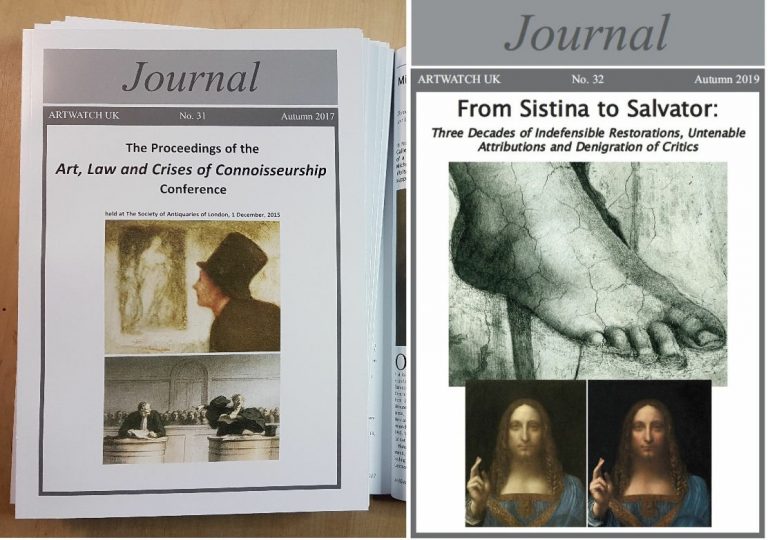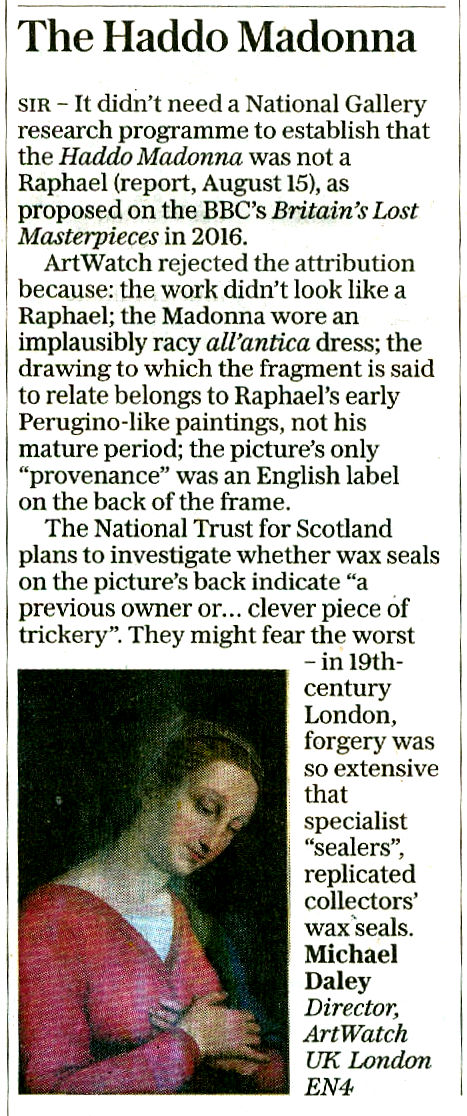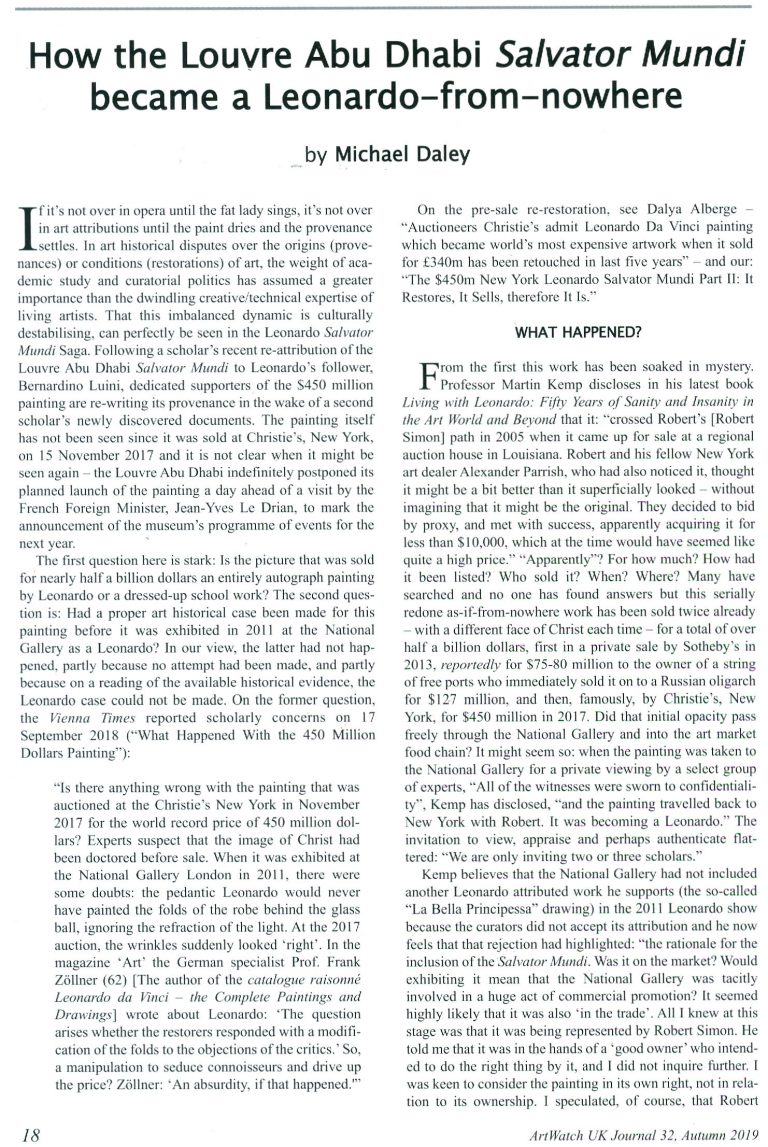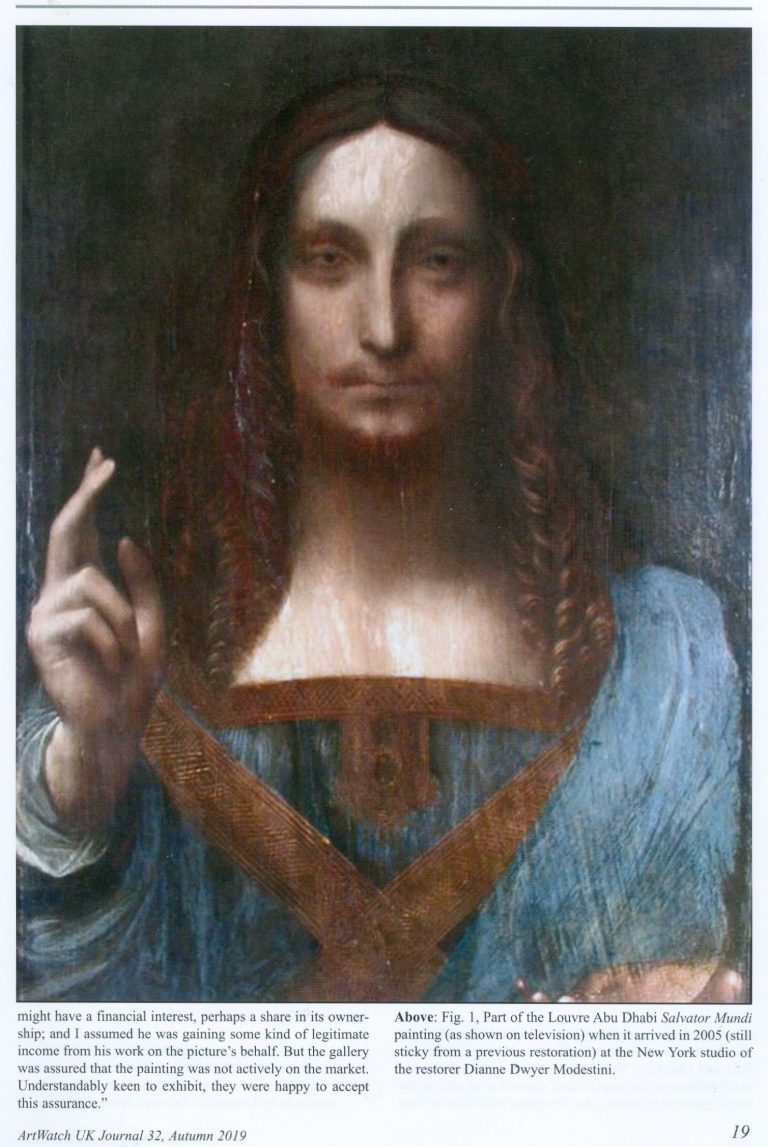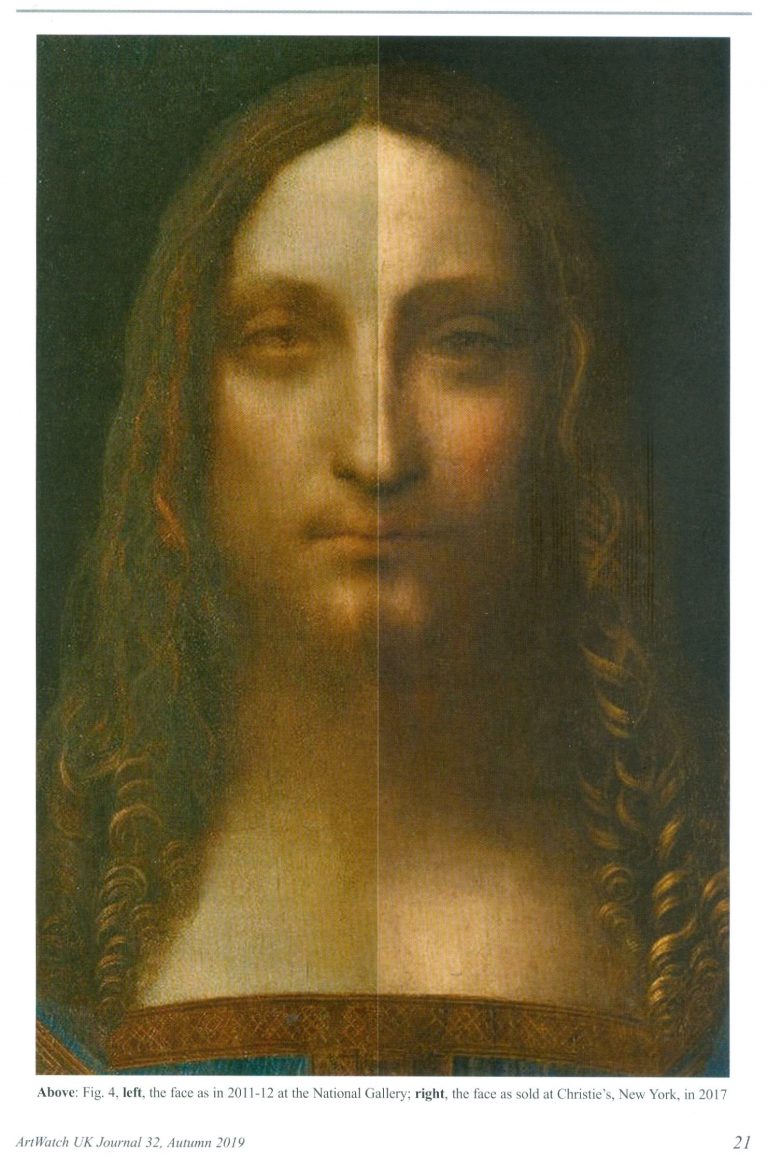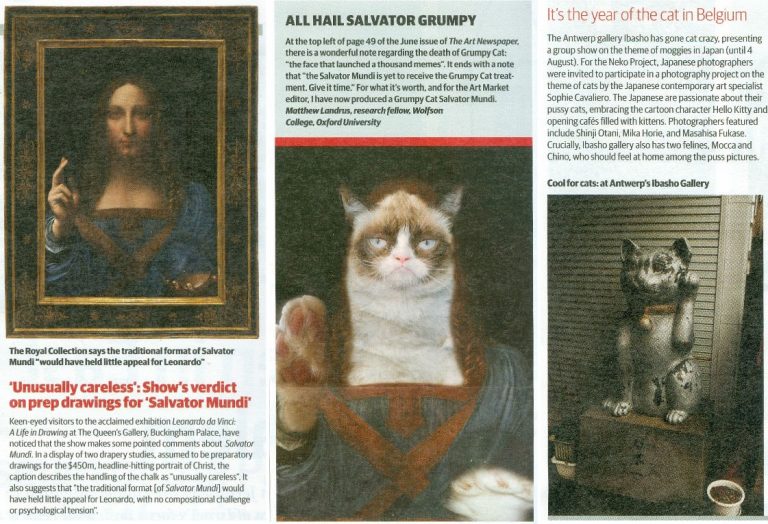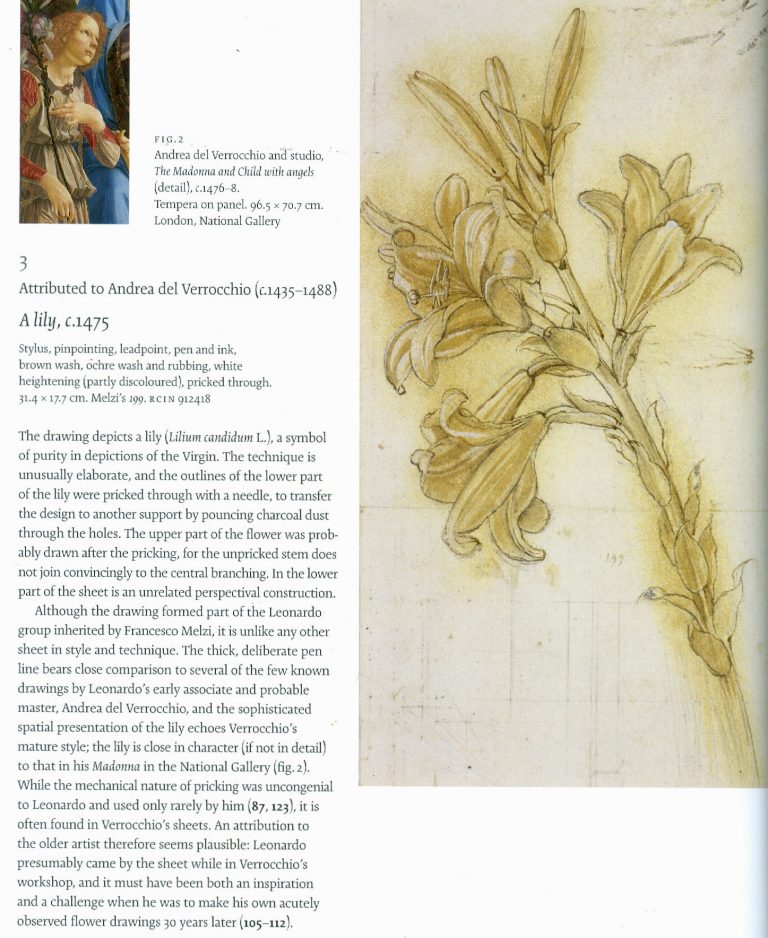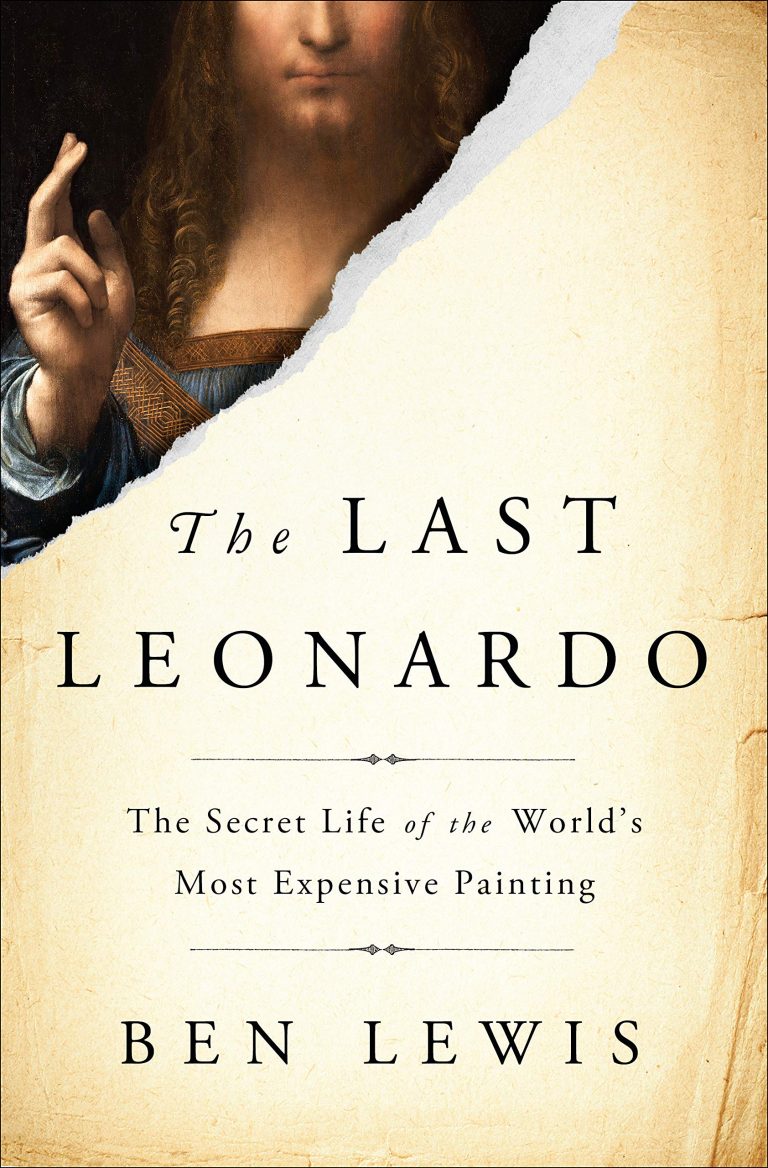The non-appearing, disappeared, $450million, now officially not-Leonardo, Salvator Mundi

Where history is generally held to be the handiwork of victors, in the art world, losers are often quickest off the block to re-write official narratives. No sooner had the catastrophic restoration losses on the Sistine Chapel ceiling become apparent than Vatican Museum officials declared that art history would have to be re-written in light of their chemically-excavated discoveries. The art historical establishment that had underwritten the restoration’s untested technical radicalism obligingly rewrote Michelangelo (as a long-unsuspected brilliant colourist) in a score of learned articles. In Italy today that exercise might seem to have succeeded: every Italian school child now learns of the “Glorious Restoration”.
Rachel Spence, the Financial Times’ reviewer of the newly opened Louvre “not-a-blockbuster” blockbuster “Léonard de Vinci” exhibition, advised (26/27 October 2019): “Forget all the brouhaha around the ‘Salvator Mundi’ (it’s not here and shows no sign of arriving)…” How sweet that invitation not-to-address must have sounded to the Louvre authorities who had asked the day after the November 2017 sale at Christie’s, New York, to borrow the by then greatly-transformed work for their long-planned 2019 Leonardo anniversary extravaganza. That request was accompanied by one from the Royal Academy craving to include the work in their great Charles I Collection blockbuster exhibition. The 2017 sale’s outcome was taken by many of the Salvator Mundi’s advocates as an absolute validation of its post-2011 upgraded ascription.
Christie’s “unusually broad consensus” of scholarly support included Vincent Delieuvin, the co-author of the present Louvre “Léonard de Vinci” exhibition. In the 2016 catalogue to the exhibition “Leonardo in Francia – Léonard en France, 1516-2016” (Figs. 2 and 3 above), held at the Italian Embassy in Paris in September/November 2016, Delieuvin wrote, p. 286: “The composition [of Salai’s Christ in the Ambrosiana, Milan] is strikingly close to Salvator Mundi, whose autograph version seems retrieved now, unfortunately in very bad condition”. Thus, in their fig. 1 reference to the restored Cook version (shown at our Fig. 1, above right, in both its 2011-12 state at the National Gallery and its 2017 Christie’s sale state) the Louvre presented the picture as the supposedly “long-lost” autograph prototype painting for the many other Salvator Mundi versions – just as it had been claimed to be by the National Gallery, in the catalogue entry for its 2011-12 Leonardo blockbuster “Leonardo da Vinci – Painter at the Court of Milan”.
In the catalogue of the present Louvre Museum Leonardo exhibition, the (absent) Salvator Mundi is no longer attributed to Leonardo da Vinci. Instead, it is simply listed as: “Fig. 103 bis, Salvator Mundi, the Cook version, c. 1505-1515”. It is reproduced in colour (p, 305) but with no catalogue entry. A chapter (pp. 302-313) by Delieuvin is devoted to a Salvator Mundi composition that has traditionally been attributed to Leonardo, though unsupported by any contemporary archival document. In other words, the New York/Abu Dhabi Salvator Mundi has reverted to being one anonymous Leonardesque painting among many “with no decisive arguments which could have let a consensus emerge [regarding the attribution to Leonardo] from the concerned specialists”. Christie’s once-vaunted “unusually broad consensus” is now no consensus at all!
Some today hold that the “brouhaha” was triggered not by the substantial and various opposition to the picture’s upgrading but by the startling auction price it achieved in 2017 ($450million). At the time of the sale, many held that the attributed picture’s astronomical sale price had crushed the work’s critics and few more so than the sometime old masters art dealer and auctioneer, Bendor Grosvenor, who gushed support for Christie’s decision to pull the Salvator Mundi away from the old masters’ sale so as to thwart the depressing effect of informed art trade “nay-sayers”:
“It’s 1 a m here in the UK and I’ve just witnessed the most extraordinary moment of auction drama at Christie’s New York (via Facebook live). Leonardo’s Salvator Mundi has sold for £400m hammer, or $450m with fees.
“The lot was first announced as ‘selling’ at $80m, which I presume represents the level of the guarantee. Bidding was then brisk to the high $100ms, before, to audible gasps in the room, the picture broke through the $200m mark. Thereafter it was a battle between two phone bidders. The winning bidder kept making unilateral bids way above the usual bidding increments. Their final gambit was to announce, with the bidding at $370m, that their next bid was $400m. This finally knocked the competition out, and – after 19 minutes – the hammer came down. Whoever it was evidently has some serious cash to burn.
“And so an Old Master painting has become the most expensive artwork ever sold. It will have completely overshadowed everything else in the sale. The next lot, a Basquiat (usually a high point for contemporary sales) bought in as the room buzzed with Leonardo chatter. Will the sale prompt people to now look anew at Old Masters? Maybe. It will surely end for good now the tired cliché that the Old Master market is dead.
“Some immediate thoughts. First, the guarantor has made a few quid, and deserves it – guaranteeing that picture at this stage in its history (post rediscovery, and in the midst of an ugly legal battle between the vendor and his agent) was quite a risk. Second, the vendor – Russian billionaire Dmitry Rybolovlev – has made about $180m. He’s in the midst of a legal battle with the person he bought the picture from, an art agent called Yves Bouvier, alleging that he was over-charged (it has been reported that Bouvier bought it from Sotheby’s for about $80m, and sold it to Rybolovlev for about $125m – allegedly). I’m not sure how that over-charging allegation plays out now.
“Third, Christie’s just did something that re-writes the history of auctioneering. They took a big gamble with their brand, their strategy to sell the picture, and not to mention the reputations of their leadership team, and they pulled it off. They marketed the picture brilliantly – the best piece of art marketing I’ve ever seen. Above all, they had absolute faith in the picture. AHN [Grosvenor’s Art History News website] congratulates them all.
“Finally, despite the fact that this picture enjoyed near universal endorsement from Leonardo scholars, and had a weight of other technical and historical evidence behind it, there was a tendency in many quarters to be sniffy about it. I found this puzzling – not just because (for what it’s worth) I believed in the picture myself – since the determination amongst some to criticise the picture was in inverse proportion to their art historical expertise. It sometimes seems that the more famous the artist, the more people assume they are an expert in them. And with Leonardo being the most famous of them all, the armchair connoisseurs have been having a field day these last few weeks.
“Anyway, I’m going to bed. What a ride. I was sure the picture would sell, but never imagined it would make this much. We must all now wonder where the picture is going to end up next.”
Two years later, when we, the Louvre, and everyone else, were still wondering where the picture might be, Grosvenor, in or out of his arm chair, suffered a reverse when his earlier television-launched Great Raphael Discovery bit the dust after professional examination at the National Gallery – as we observed in the 19 August 2019 Daily Telegraph:
In 2018 Professor Martin Kemp, a key member of the Scholarly Consensus was cooler on Christie’s choice of sale in his memoir Living with Leonardo:
“It was, however, a great surprise to find that the Salvator was to be sold Christie’s in New York on 15 November 2017 in a mega-auction of celebrity works of art from the modern era. [Some saw that as being apt in view of the picture’s extensive repainting.] The auctioneers sent the painting on a glamorous marketing tour of Hong Kong, San Francisco and London. I was approached by the auctioneers to confirm my research and agreed to record a video interview to combat the misinformation appearing in the press – providing I was not drawn into the actual sale process.
“The price inched upwards from less than $100 million to $450 million, shattering the world record for a work of art. The result was cheered to the rafters. I was besieged by media requests for comment. Three weeks later reports that it had been purchased by one of two Saudi princes began to circulate, prompting Christie’s to announce that it had been acquired by Abu Dhabi’s Department of Culture and Tourism for the Louvre Abu Dhabi, the remarkable new ‘world museum’, where it will join Leonardo’s La belle Ferronnière. A public home at last, I hope.”
The brouhaha should not be brushed aside. Too many urgent issues have arisen concerning, for example, the singular debate and scrutiny-avoiding means by which the supposedly solid consensus was assembled (- and, on this, see Ben Lewis’s The Last Leonardo), and the top-secret restoration work that was carried out at the Conservation Center of New York University’s prestigious Institute of Fine Arts, during which covert operation the drapery at the (true) left shoulder of Christ was transformed and simplified (Figs. 1 above and 7 below) immediately ahead of the pre-sale world marketing tour – as revealed in “Auctioneers Christie’s admit Leonardo da Vinci painting which became the world’s most expensive artwork when it sold for $340m has been retouched in the last five years”. While in truth we still don’t know the whole story or even the post-sale whereabouts of the picture, much of the recent ground is covered in the ArtWatch UK members’ Journal No 32, as sampled in Figs. 5-8 below. [AWUK Journals are distributed free to members. New members receive the previous two issues – presently as shown at Fig. 1 above. For membership application details please write to Membership at: artwatch.uk@gmail.com ]
Michael Daley, Director, 28 October 2019
SALVATOR GRUMPI – UPDATED
The July/August issue of the Art Newspaper carries three fascinating items on the standing of the disappeared Salvator Mundi painting which may or may not be included in the forthcoming Leonardo exhibition at the Louvre.
It was sharp of the Art Newspaper to spot the inconsistency (above, left) at the Queen’s Gallery exhibition “Leonardo da Vinci: A Life in Drawing”. Two months ago, the Guardian reported that Martin Clayton, head of prints and drawings at the Royal Collection Trust, had said that while some experts still doubt its authenticity: “For what it’s worth, I believe it is [a Leonardo].” He then made this extraordinary claim:
“My opinion is not a controversial one among Leonardo scholars … the more somebody knows about Leonardo the more likely they are to accept the painting and the people who have been saying ‘no, Leonardo would never paint anything like that’ tend to be people who, to be frank, aren’t great Leonardo scholars.”
This seemed both ill-informed and rash. Does Clayton take himself to be a better judge of Leonardo matters than say – just to name two prominent Salvator Mundi dissenters – Carmen Bambach, curator of Drawings and Prints at the Metropolitan Museum of Art and author of the recently published four-volume study Leonardo da Vinci Rediscovered, or, Frank Zöllner, author of the Leonardo catalogue raisonné? Contrary to claims made by the National Gallery and Christie’s, the author Ben Lewis has disclosed in his book The Last Leonardo that when the Salvator Mundi was examined at the National Gallery in 2008 – in one of its earlier restoration incarnations – only two out of five leading Leonardo scholars endorsed the then proposed Leonardo attribution.
Tonight Martin Clayton chairs a discussion at the Queen’s Gallery with the experts, Adam Rutherford, Maya Corry and Matthew Landrus, on the ways Leonardo understood observation and drawing while combining art and science in every aspect of his work. The event is a sell-out and, unfortunately, the Gallery declined to admit ArtWatch to cover the event for our forth-coming Journal on the theme “From Sistina to Salvator”.
Michael Daley, 4 July 2019
Update, 10 July 2019 – ATTRIBUTING UP AND ATTRIBUTING DOWN
Two ArtWatchers’ present at the (£15) Leonardo observation/drawing/science discussion, report that in the “Leonardo da Vinci – a Life in Drawing” exhibition catalogue, Martin Clayton takes the c. 1475 drawing, A Lily, from Leonardo and attributes it to the artist’s master, Andrea del Verrocchio, on the grounds that the drawing bears “close comparison to several of the few known drawings” attributed to Verrocchio (Fig. 1 below). The claim goes unsupported visually. Clayton has reportedly acknowledged that:
“The Royal Collection has one less Leonardo drawing, but we have one more Verrocchio, which is even more exciting. This is our only Verrocchio. We don’t have any other drawings by [him]” and “Whereas his sculpture and architecture is very well known, very few of his drawings survive. We have something like 1,000 artistic drawings by Leonardo, whereas we have about 10 – if that – by Verrocchio [worldwide]. So, in a sense the subtraction of one drawing from Leonardo’s oeuvre matters hardly at all, whereas the addition of one drawing of Verrocchio’s is a big deal. That’s why I find it exciting… It is one of the most beautiful of his few drawings.”
For those who care about works of art as art – and not as quasi-philatelic holdings – it matters a very great deal. Consider the logic: if we re-attribute a (fabulous) Leonardo plant study and place it among Verrocchio’s very few drawings it becomes…one of the latter’s most beautiful drawings. That is an alarm bell – it should look at home in the oeuvre. In answer to the question how comfortably or plausibly the Lily sits among Verrocchio’s few drawings, Clayton’s case is twofold. First, “Leonardo’s earliest drawings do not feature the bold, confident line seen here”; then, an acknowledgement/assertion that although there is “no direct parallel in the few known drawings by Verrocchio, this penwork is close to that in his Head of an Angel and the double-sided Study of Putti”. And, for that reason: “An attribution to Verrocchio of this accomplished drawing thus seems preferable.”
“Preferable” is an odd word in this context and is not the same thing as “more secure”. Moreover, if we juxtapose the details of the Leonardo Lily and the Verrocchio angel (as above at Fig. 2) we do not find a common bold line or a common anything. The drawing of the hair has none of the fluency of design or eloquent plasticity of the Lily. I first encountered the Lily at sixteen in a regional art school library Phaidon book, (probably Goldscheider’s Leonardo da Vinci). Then, I found it and Leonardo’s drapery studies breath-taking in their acuity and realisation of form-on-a-flat-surface. I still do. In Verrocchio’s oeuvre, the Lily is both atypical and most beautiful. This should not surprise: above grace and elegance, in this particular drawn stalk of flowers Leonardo had summoned a force of nature in an image that pulsates with life as it unfurls before us (Fig. 3).
Clayton’s principal justification for making his dramatic demotion is that the Lily constitutes a unicum within Leonardo’s surviving drawings oeuvre. It does but, then, it constitutes a more pronounced one in Verrochio’s tiny oeuvre. In making this switch Clayton discounts earlier scholarship on the drawing’s special status. Ann Pizzorusso kindly points out that while acknowledging the drawing’s distinctive nature, the late Carlo Pedretti had seen no disqualification. In Leonardo da Vinci Nature Studies from the Royal Library at Windsor Castle Pedretti noted that in nearly every one of his early paintings, Leonardo addressed landscape and “in particular” vegetation – where “Plants and flowers are consistently represented with scientific accuracy…” Moreover, “Evidence of Leonardo’s extensive study of plants and flowers in his youth is provided by Leonardo himself as he records ‘molto fiori ritratti di naturale’ in the list of works that in about 1482 he was taking to Milan or leaving in Florence…”
Whatever administrative benefits this effective de-attribution may bring, it neither rests on visual demonstration nor makes artistic sense. In our view, Clayton has thus committed a double Leonardo attribution error: he takes the now disappeared, much-restored and re-restored $450 million Salvator Mundi as a fully autograph Leonardo prototype painting and, he gives away one of Leonardo’s most brilliant studies. In both exercises methodological shortcomings are evident: neither the re-attribution nor the attribution upgrade followed a due presentation of evidence and invitation to debate. With the Salvator Mundi it is claimed that the (surviving) hair constitutes proof of Leonardo’s hand. It does nothing of the sort. Martin Kemp, the painting’s most vocal advocate, places the Salvator Mundi between the Mona Lisa and the St. John – in other words, at the very peak of Leonardo’s painterly accomplishment. In the comparison below (Fig. 4) we show details of the hair of the St. John, left, and the Salvator Mundi, right. By comparison with the secure St. John, the hair of the Salvator Mundi can be seen to be less sumptuously formed, more linear, sharper and metallic – like lathe turnings. The differences of painterly sophistication in these two works greatly outweigh any similarities of design.
Where the Lily seems to have been downgraded by a single scholar’s proclamation, with the Salvator Mundi, as Ben Lewis* has chronicled in his book, The Last Leonardo – The secret Lives of the World’s Most Expensive Painting, the attribution was made through a cumulative series of covert manoeuvres between 2005 and 2011, at which late date the painting was sprung on the world with the full authority of a National Gallery director, curator and trustee, as an entirely autograph Leonardo painted prototype in the Gallery’s major Leonardo Painter at the Court of Milan blockbuster exhibition. To Lewis, Luke Syson, the exhibition curator, admits erring in his catalogue entry on the painting (which was indebted to the then – and still – unpublished papers of one of the owners). Specifically, Syson confesses: “I catalogued it more firmly in the exhibition as a Leonardo because my feeling was that I was making a proposal and I could make it cautiously or with some degree of scholarly oomph”. Nothing indicated to the reader or the exhibition visitor that a proposal was being made. As Syson put it in his entry: “The re-emergence of this picture, cleaned and restored to reveal an autograph work by Leonardo, therefore comes as an extraordinary surprise.” No “ifs”, no “buts”, this was a long-lost Leonardo. On which claimed certainty, see our review of Lewis’s book in “Selling a Leonardo with ‘oomph’” in the July/August 2019 issue of the Jackdaw.
A CURATE’S EGG OF AN ATTRIBUTION
In March 2008 five Leonardo scholars were invited to examine the Salvator Mundi in its then state of restoration. Martin Kemp has reproduced the emailed invitation he received from the Gallery’s then director, Nicholas Penny:
“I would like to invite you to examine a damaged old painting of Christ as Salvator Mundi which is in private hands in New York. Now it has been cleaned, Luke Syson and I, together with our colleagues in both paintings and drawings at the Met, are convinced that it is Leonardo’s original version, although some of us consider that there may be [parts?] which are by the workshop. We hope to have the painting in the National Gallery sometime in March or in April so that it can be examined next to our version of the Virgin of the Rocks. The best-preserved passages in the Salvator Mundi panel are very similar to parts of the latter painting. Would you be free to come to London at any time in this period? We are only inviting two or three scholars.”
In the event, five scholars were invited, and, Ben Lewis has established, of those, two accepted the attribution, one rejected it and two declined to offer a judgement. Kemp did accept it and he has further disclosed that: “All of the witnesses in the conservation studio were sworn to confidentiality, and the painting travelled back to New York with Robert [Simon, one of the consortium of owners who had bought the painting for $1,175 in 2005]. It was becoming ‘a Leonardo’.” And so it was. Having done so and having twice been sold as such for a total of over half a billion dollars, it disappeared. Its whereabouts remain unknown.
*Ben Lewis will deliver the tenth ArtWatch International James Beck Memorial Lecture (“Fingers Crossed: Wishful Thinking, White Lies, Benedictions and the Attribution of the Salvator Mundi”) in London, on Tuesday October 1st. Details to be announced shortly.

